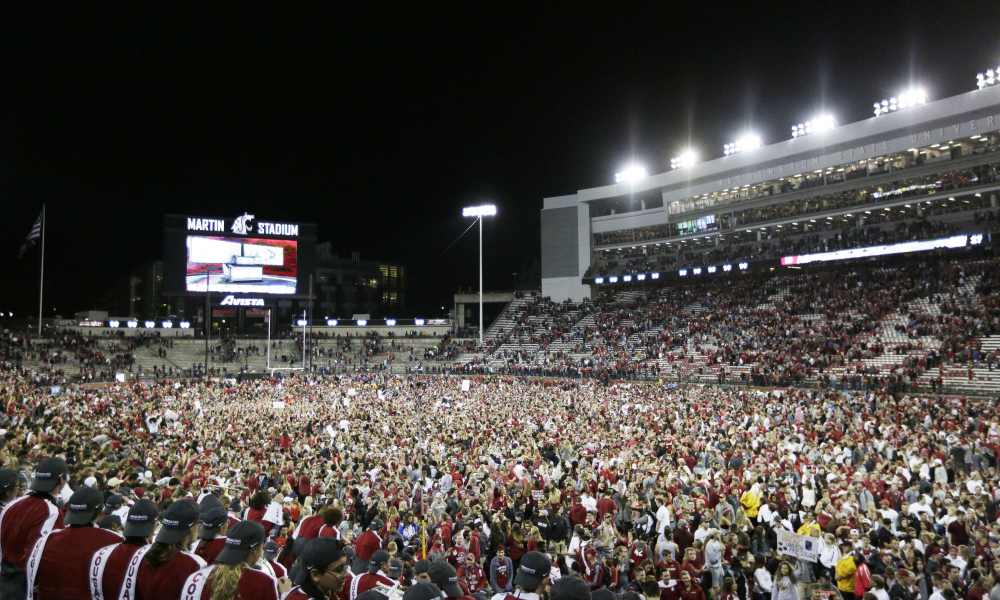
WSU Outlines Plan To Reduce Projected $85 Million Athletics Deficit
Listen
Update, June 8, 2018:
The Washington State University board of regents unanimously approved a plan today aimed at reducing its nearly $68 million athletics department deficit.
The regents passed a yearly operating budget hoping to cut down annual athletics shortfalls that require money transfers from other non-academic university areas in order not to end the fiscal year in the red. Then the money will be transferred back at the start of the new fiscal year, July 1.
But long-term, the plan anticipates annual operating deficits until 2022, which could cause the cumulative athletics deficit to rise to nearly $85 million.
2023 is the first year WSU officials project to have an annual budget surplus in athletics, and can begin paying down the entire department debt.
In that time, total salaries for coaches are projected to rise from nearly $13 million now to nearly $16 million by 2023.
Original story, May 31, 2018:
Washington State University’s athletics department is currently facing a nearly $67 million budget deficit as the 2018 fiscal year ends. But the deficit is projected to grow much larger before it goes down.
Now, WSU leaders are outlining a plan to get the department back to fiscal stability.
Today, athletic director Pat Chun and university chief budget officer Joan King talked with reporters about a plan going before the WSU Board of Regents to consider at their next meeting on June 8.
Included in the plan: transferring nearly $70 million from non-academic units like housing and dining and student health services to athletics in order to end this fiscal year in the black. (WSU’s current fiscal year ends June 30.)
Then the money will be transferred back immediately at the start of the next fiscal year, which begins July 1.
The university is doing this in an open setting because they are now required to do so. The Washington legislature passed a law just this year mandating all state universities adopt their proposed athletic budgets in an open meeting and post them online. That wasn’t previously required. (Read text of SSB 6493.)
“We are not here to make excuses,” said athletic director Pat Chun, who was hired in January to replace Bill Moos after Moos departed for Nebraska. The deficits first happened under Moos’ leadership when the school invested heavily in new facilities and high-priced coaches.
“We are here to move forward, take fiscal responsibility and provide a world-class student-athlete experience,” Chun said on a conference call to reporters. “There is not an overnight solution to our budget issue.”
The reduction plan anticipates WSU’s cumulative athletics deficit growing to almost $85 million by the end of the 2023 fiscal year. That’s the first year the athletics department is projected to end a single budget year in positive territory, with a $200,000 surplus. But if the projection holds, that would only be a single year positive budget for the athletics department. It would still have the cumulative deficit of nearly $85 million to pay down.
This athletics deficit-reduction plan is happening at the same time the entire university is under larger budget constraints stemming from overspending across the university by $25 million each year over the past four years.
Because of that overspending, academic units have been directed to reduce expenditures by as much as two and a half percent this year and next compared to previous years. Additionally, the WSU Performing Arts program was eliminated at the conclusion of the 2018 spring semester to reduce overall university spending.
Much of the athletics department deficit is connected to new facilities, such as a $61 million football operations complex. Football coach Mike Leach is paid $3.5 million per year.
Between now and 2023, total compensation for coaches is projected to rise from nearly $13 million now to almost $16 million. Along with compensation for administrative staff, that is the largest single expense for WSU athletics.
NOTE: WSU holds the broadcast license of Northwest Public Broadcasting, though NWPB is editorially independent.
Reporting from the Associated Press was used in this story.
Related Stories:

WSU, UI students join protests of U.S. support to Israel
Students in the Inland Northwest this week joined growing antiwar protests at schools across the country. Continue Reading WSU, UI students join protests of U.S. support to Israel

New golden eagle to provide Yakama Nation with sacred ceremonial feathers
Yakama Nation aviary biologists Michael Beckler (left) and Alyssa Woodward pose for a photo with Yakama Nation Tribal Council member Terry Heemsah (center) as Washington State University wildlife veterinarian Dr.… Continue Reading New golden eagle to provide Yakama Nation with sacred ceremonial feathers

WSU’S Coalition of Academic Student Employees ratifies its first contract
At academic institutions nationwide, student workers continue to organize, and this week, those at Washington State University got a big win.
The Coalition of Academic Student Employees has ratified its first union contract. With the agreement, student employees will get paid vacation for the first time, as well as earn six weeks of paid parental leave.
Continue Reading WSU’S Coalition of Academic Student Employees ratifies its first contract














